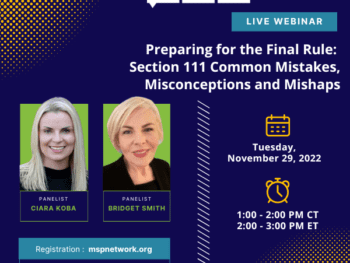Published originally on January 30, 2017 – WorkCompWire
By Dan Anders, Chief Compliance Officer, Tower MSA Partners
 The saying goes you can’t teach old dogs new tricks. But when it comes to clinically driven settlement initiatives involving complex “old dog” workers’ compensation claims, old dogs can be taught new tricks. What’s more, the lessons learned from old dog claims can become a foundation for “new tricks” that can be applied in the management of all claims, building a best practices model that stops the cycle.
The saying goes you can’t teach old dogs new tricks. But when it comes to clinically driven settlement initiatives involving complex “old dog” workers’ compensation claims, old dogs can be taught new tricks. What’s more, the lessons learned from old dog claims can become a foundation for “new tricks” that can be applied in the management of all claims, building a best practices model that stops the cycle.
Click Link to Access Free PDF Download
“8 ‘Think Outside the Box’ Tactics to Settle Workers’ Comp Claims”
“Old dog” claims refer to legacy claims or claims which have been open for some time and continue to draw down on the indemnity and medical reserves as a result of ongoing time off work and/or continued medical care. Old dog claims can come from a merger or acquisition, especially if the companies have different claims management and settlement philosophies. Complex claims that were once in front of an adjuster on a regular basis may also become old dogs when shunted aside by an influx of new claims.
Whether triggered by a merger, a change in management or the sheer volume of legacy claims, an aggressive settlement initiative can push many old dog claims to closure, and if not closure, there is clear communication that changes will occur. Whether through settlement or a change in treatment, the “old dog” will learn “new tricks.”
Successful settlement initiatives involve multiple partners, first to identify and analyze cost drivers across a large number of old open claims, then match them with appropriate interventions (file review, physician peer review, clinical oversight, legal action) to resolve all issues blocking settlement. Once the obstacles are addressed, the next step is to work with the settlement partner to create an incentive for both injured worker and payer. If settlement can be achieved, it is a win, win for all stakeholders. If settlement isn’t possible, injured workers and their physicians are challenged within the context of jurisdictionally approved treatment guidelines to improve care.
If executed consistently as part of a strategic plan to identify, intervene and remain involved until closure, the lessons learned from this type of settlement initiative will become imbedded into the claims management culture of the payer.
Identifying and Analyzing Claim Cost Drivers
Consider the case of an employer with longstanding open medical and legacy claims. Some of these claims may involve injured employees who are actively treating, even if it is just maintaining medications, while others may involve patients whose current medical condition is unknown. In either case, the employer’s first step is a file review that identifies claims in need of addressing for case settlement. The next step is the employer involving a strategic clinical partner to properly assess ongoing and future medical exposure, if any.
The best methods for analyzing future medical exposure are through a medical cost projection or a Medicare Set-Aside (MSA) if the claimant is a Medicare beneficiary or close to becoming one. An MSA has the added benefit of limiting medical care to treatment and medications that are Medicare-covered, thus potentially reducing future medical exposure for settlement. The goal of either method is to identify any red flags, such as:
- Use of opioids, muscle relaxants and NSAIDS
- Multiple prescribers of medications
- Open-ended recommendations for surgery
- Spinal cord stimulator recommendation
- Prescription history that is inconsistent with the medical records
- Most recent treatment date is so old that it leaves medical care open ended
- Indication outside of medical records that injured employee continues to treat, but not through the workers’ compensation claim
The clinical partner needs to understand how the legal aspects of a claim (denied body parts and conditions and legal determinations) impact the assessment of future medical care and to be able to work effectively with defense counsel to limit ongoing and future medical care. Once the clinical partner projects future medical care and identifies red flags, the partner and employer should separate the claims into those that can immediately move to settlement negotiation, those that could settle after clinical or legal intervention, and those that are unlikely to benefit from intervention and thus cannot settle.
Appropriate Clinical Interventions
One size does not fit all when it comes to the right intervention to impact the medical care on a claim. If old medical records indicate open-ended medical care, then the intervention plan may involve the clinical partner contacting the last treating physician to confirm there has been no medical care delivered since the last date of service. If there has been medical care, the partner may track down additional medical records and assess future medical care based upon those records.
If there is a significant medication spend, a physician peer review may be the most appropriate claim intervention. A physician peer review is conducted by a practicing physician who performs an in-depth analysis of an injured employee’s medication regimen, comparing it to evidence-based medical and pharmaceutical guidelines. The physician peer reviewer then contacts the treating physician and discusses the drug regimen and current guidelines and asks the treating physician to change the pharmacy treatment or the medical treatment plan. The clinical partner obtains the treating physician’s written agreement to change the course of medical treatment and drug regimen. The partner follows up with the physician to ensure that changes actually occur and secures copies of medical records documenting the changes prior to preparing a settlement document.
Claim Closure
Once changes to medical and pharmaceutical care take place, the clinical partner works with the employer or carrier to revise the initial projections of future medical care whether contained in a medical cost projection or an MSA. If the latter, the MSA should be submitted to the Centers for Medicare and Medicaid Services (CMS) for approval. A settlement team should be assembled to work with the adjuster or a manager to complete negotiations and finalize the settlement.
About Dan Anders
Daniel M. Anders, Esq., MSCC is the Chief Compliance Officer for Tower MSA Partners. A certified Medicare Set-Aside Consultant and attorney, he oversees the Medicare Secondary Payer (MSP) compliance program. Mr. Anders is responsible for ensuring the integrity and quality of the MSA program and other services and products and he provides education and consultation to Tower MSA clients on all aspects of MSP compliance.
Mr. Anders is the former Senior Vice-President of MSP Compliance for ExamWorks Clinical Solutions and he has extensive litigation experience from his prior position with the Chicago law firm of Wiedner & McAuliffe. He holds a Juris Doctor from Chicago-Kent College of Law and a Bachelor of Arts degree from Loyola University Chicago.
Contact Mr. Anders at 847.946.2880 or [email protected]
About Tower MSA Partners
 Tower MSA Partners is a national provider of Medicare Secondary Payer services, including Section 111 Reporting and Conditional Payments along with Medicare Set-Aside preparation, submission and oversight. Its proprietary MSP Automation Technology Suite drives MSP compliance best practices and provides end-to-end visibility into each activity. Tower’s other services include pre-MSA Triage, physician peer reviews, MSA administration, medical cost projections, and life care plans. With more than 50 years combined experience in pharmacy, legal oversight and medical care, Tower proactively stages claims and works collaboratively with clients to identify issues and intervene to modify outcomes. Tower remains involved in the claims, through final resolution, MSA and/or other settlement. This model enables Tower’s clients to provide better care to injured workers, reduce claim and MSA costs, and obtain CMS acceptance of the MSA. For more information, visit www.towermsa.com and subscribe to Tower’s www.mspcomplianceblog.com.
Tower MSA Partners is a national provider of Medicare Secondary Payer services, including Section 111 Reporting and Conditional Payments along with Medicare Set-Aside preparation, submission and oversight. Its proprietary MSP Automation Technology Suite drives MSP compliance best practices and provides end-to-end visibility into each activity. Tower’s other services include pre-MSA Triage, physician peer reviews, MSA administration, medical cost projections, and life care plans. With more than 50 years combined experience in pharmacy, legal oversight and medical care, Tower proactively stages claims and works collaboratively with clients to identify issues and intervene to modify outcomes. Tower remains involved in the claims, through final resolution, MSA and/or other settlement. This model enables Tower’s clients to provide better care to injured workers, reduce claim and MSA costs, and obtain CMS acceptance of the MSA. For more information, visit www.towermsa.com and subscribe to Tower’s www.mspcomplianceblog.com.












